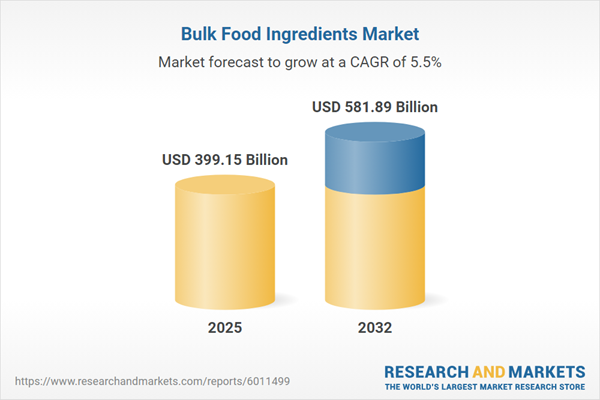Speak directly to the analyst to clarify any post sales queries you may have.
The bulk food ingredients market is undergoing rapid change as technology, evolving regulations, and shifting buyer expectations reshape supply strategies and procurement frameworks. Senior decision-makers are revising their sourcing plans to bolster organizational resilience and secure long-term value in a dynamic global landscape.
Market Snapshot: Bulk Food Ingredients Market Growth and Industry Shifts
With increased organizational emphasis on wellness, end-to-end safety, and supply chain performance, the bulk food ingredients market is expanding steadily. Enterprises are investing in digital transformation initiatives, especially within procurement and logistics, to boost operational transparency and strengthen partner trust. Deployment of advanced compliance and traceability technology is enhancing the resilience of supply chains, helping firms address external disruptions effectively. Throughout the industry, innovative ingredient solutions and modern sourcing tactics are enabling companies to remain competitive as global conditions become more challenging, with particular focus on agility and cost efficiency.
Scope & Segmentation: Bulk Food Ingredients Market Overview
A clear understanding of market segmentation equips executive teams with the insights necessary for agile sourcing and robust supply reliability. This structure supports improved risk planning and real-time responses to shifting market dynamics. The segmentation encompasses multiple dimensions, each with strategic implications for operational planning and brand differentiation.
- Type: Acidulants, emulsifiers, flavors (natural and artificial), color additives, leavening agents, lipid ingredients, proteins and amino acids (including soy, whey, pea), hydrocolloids, starches, and sweeteners; each group underpins product differentiation and facilitates a wide range of manufacturing solutions.
- Application: Bakery, confectionery, dairy, beverages, infant nutrition, meat processing, sauces, dressings, and snacks; each application segment presents unique compliance requirements, promoting focused sourcing and formulation approaches.
- Form: Gels, granules, liquids, powders; these various forms grant manufacturers versatility in both mainstream and specialty production environments.
- End Use Industry: Food and beverage, animal feed, personal care, pharmaceuticals; the broad industry coverage underscores the market’s cross-sector relevance and need for robust ingredient supply chains.
- Distribution Channel: Direct sourcing from manufacturers, established distributor networks, and the rising use of digital procurement platforms; these options increase flexibility and market reach globally and regionally.
- Certification: Conventional, organic, and non-GMO certifications enable suppliers to align with evolving regulatory and consumer standards across varied geographies.
- Geographies: Americas, Europe, Middle East, Africa (including UK, Germany, UAE, South Africa), Asia-Pacific; regional characteristics shape compliance, operational platforms, and route-to-market decisions, led by diverse levels of maturity and demand catalysts.
- Key Companies: Cargill, Archer-Daniels-Midland Company, International Flavors & Fragrances Inc., Tate & Lyle PLC, Ingredion Incorporated, Givaudan SA, Kerry Group plc, Koninklijke DSM N.V., Bunge Limited, Associated British Foods plc; these leaders highlight a competitive landscape with strong global representation.
Key Takeaways for Senior Decision-Makers
- Digital traceability technologies such as IoT and blockchain are transforming transparency standards, supporting rapid procurement responses, and strengthening quality in supply and logistics management.
- Demand for clean-label and plant-based ingredients is shaping ingredient portfolios, with organizations investing in fermentation-derived and non-traditional alternatives for competitive positioning.
- Adaptation to evolving sustainability expectations remains essential as regulatory frameworks and environmental priorities affect sourcing, production, and brand strategy.
- Expanding supplier networks and diversifying sourcing channels are widely adopted strategies, reducing operational dependence on individual suppliers and mitigating supply risks.
- Strategic collaboration among production, distribution, and manufacturing functions boosts compliance management and accelerates the rollout of new product formulations.
- There are notable regional distinctions: Asia-Pacific is advancing reformulation trends, while North America and Europe focus on processing efficiencies and customized solutions to meet evolving client needs.
Tariff Impact on Supply Strategy and Cost Optimization
Volatile tariff landscapes, notably those affecting the United States, are driving companies to reevaluate sourcing routes and supply structures. Heightened emphasis on regional and domestic supplier relationships enhances risk control, supply continuity, and cost management in response to dynamic trade policy shifts. These measures strengthen business continuity and operational durability amid market unpredictability.
Methodology & Data Sources
This market analysis integrates comprehensive secondary research, thorough regulatory reviews, and direct input from key producers, distributors, and compliance authorities in the bulk food ingredients sector. Insights are validated by subject-matter experts to ensure practical value for executive decision-making.
Why This Bulk Food Ingredients Market Report Matters
- Provides actionable and market-aligned intelligence for shaping sourcing strategies, mapping investments, and staying agile during industry transformation.
- Enables organizations to respond confidently to regulatory developments, accelerate digital procurement initiatives, and optimize supply chains for future resilience.
- Supports sustainable procurement practices that uphold supply chain integrity and long-term competitive advantage.
Conclusion
This report serves as a strategic resource for industry leaders, offering clear, actionable guidance on evolving trends and equipping organizations to make proactive, future-focused decisions in the bulk food ingredients market.
Additional Product Information:
- Purchase of this report includes 1 year online access with quarterly updates.
- This report can be updated on request. Please contact our Customer Experience team using the Ask a Question widget on our website.
Table of Contents
3. Executive Summary
4. Market Overview
7. Cumulative Impact of Artificial Intelligence 2025
Companies Mentioned
The companies profiled in this Bulk Food Ingredients market report include:- Cargill, Incorporated
- Archer-Daniels-Midland Company
- International Flavors & Fragrances Inc.
- Tate & Lyle PLC
- Ingredion Incorporated
- Givaudan SA
- Kerry Group PLC
- Koninklijke DSM N.V.
- Bunge Limited
- Associated British Foods PLC
Table Information
| Report Attribute | Details |
|---|---|
| No. of Pages | 193 |
| Published | November 2025 |
| Forecast Period | 2025 - 2032 |
| Estimated Market Value ( USD | $ 399.15 Billion |
| Forecasted Market Value ( USD | $ 581.89 Billion |
| Compound Annual Growth Rate | 5.5% |
| Regions Covered | Global |
| No. of Companies Mentioned | 11 |









